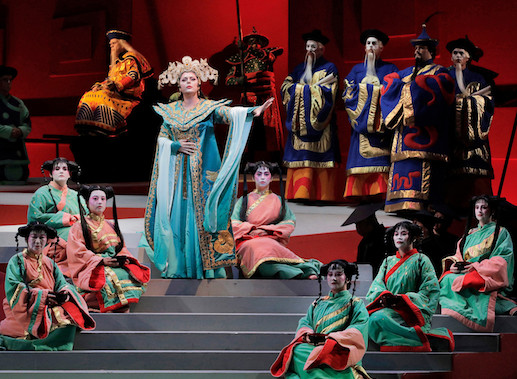
As the opening opera of San Francisco Opera’s season, Turandot, Puccini’s final and famously incomplete opera, provides all the grandeur and lavish orchestration needed, stating that opera, finally, is a world seething with color, violence and love.
This is stated visually in this production, as well as aurally. The refurbished sets by David Hockney, which debuted in San Francisco in 1987 and have been restaged four times since, emphasize the drama by greeting the audience’s eyes with walls of deep reds, capped by the blue green curves of pagoda roofs; the natural world hovering above in cobalt blues and purple shadows. The sets big curvy lines looking like blow-ups from magic marker sketches.
The costuming by Ian Falconer picks up the carnival colors of Hockney’s sets, with additional colors reminiscent of the Ballet Russe’s more exotic and eastward-turning costume designs by Natalia Goncharova and Nicholas Roerich. The costumes’ geometric shapes and padded forms also evoked Picasso’s costume design for the Chinese Conjurer in the Ballet Russes’ Parade.
All that along with gong-driven percussion and the unmistakable Puccini sound calls up a world of the imagination, one resembling a poet’s dream of a world and time both distant and legendary, something imagined from before the era of multifarious Star Wars. The libretto describes the opera as placed “outside the walls of the great Violet City.” Peking in the background, gold and gleaming.
Color in this Turandot is, like love, a force rather than a sigh.
The action of the story is itself seated in the imagination. The Princess Turandot refuses to marry, and she does so based on an ancient story that has gripped her and frozen her emotions. Her ancestress, Princess Lo-u-Ling, reigned in joy, free from male domination, until she was raped and murdered by an invading foreign prince. Turandot believes that the soul of Lo-u-Ling lives within her, and swears she will never submit to any man. In order to formalize her claim, she sets up a life-and-death challenge. Any would-be suitor must answer three riddles; the price for a wrong guess is the suitor’s head.
Soprano Martina Serafin makes a beautiful and majestic Turandot. When she delivers this story of ancient injustice, she seems cloaked in a dark and remote sound; her lower register countered by a focused intensity in the upper forte notes, both of which project a forbidding inaccessibility.
That intensity was matched by tenor Brian Jagde, whose voice projected victory more than tender love. His Calaf, the Unknown Prince who falls instantly and recklessly in love with Turandot, was a man out to win what he desires. Even when he turned his fate over to Turandot, giving her his name and thereby allowing her the ability to sentence him to death, there was a macho confidence in his singing. Both singers were well matched in their power and icy determination.
Countering them were Calaf’s father Timur and the slave girl Liu. Bass Raymond Aceto has one of those gorgeously warm deep voices, vibrant with emotion. Toni Marie Palmertree sang the sweetly loving Liu, who gives her life so that Calaf can win the love of Turandot.
Baritone Joo Won Kang (Ping), tenors Julius Ahn (Pang) and Joel Sorensen (Pong) sang the comic courtiers who provide a sentimental relief from the action by reminiscing over their homelands that they had left for the sullen court of Turandot.
There is something intellectual about Turandot. The riddles invariably pull the viewer into the drama, more so than Calaf’s famous aria “Nessun dorma”, which provides the final thematic and choral splendor of the opera. Turandot’s riddles are more abstruse than anything posed by a wagering Norseman. And Calaf’s strategy to win the princess’ love answers her challenge with its own strangely mental courtship: another riddle, which Turandot answers with an equally abstruse (though gratifying) answer. Throughout the opera there is a psychological narrative that is both sophisticated and cerebral. And the singers in this particular production leaned toward the cool and triumphant, providing an intriguing version of Puccini’s opera.
The orchestra, under the direction of Company Music Director Nicola Luisotti who is leaving soon to take the position of associate musical director of Madrid’s Teatro Real, was its usual splendid self, emphasizing the grandeur and formal attractiveness of the opera.
– Jaime Robles
San Francisco Opera’s Turandot continues through December 9. For information and tickets, visit sfopera.com.
Photo: Martina Serafin as Turandot. Photo by Cory Weaver.
